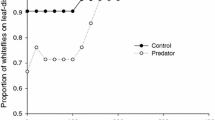Abstract
Western tussock moths (Orgyia vetusta Bdv., Lymantriidae) infest one stand of bush lupine (Lupinus arboreus Sims, Fabaceae) heavily and several other stands very lightly at the Bodega Marine Reserve (Sonoma Co., Calif., USA). We found that the disappearance rates of experimentally placed larvae and pupae were consistently lower in the outbreak area than in non-outbreak areas. For pupae but not larvae, this difference was removed by using tanglefoot to repel nonflying predators. However, the major nonflying predator of pupae, the ant Formica lasioides, was no more abundant in non-outbreak areas than in the outbreak area. We found inverse density-dependence in the rate of attack by F. lasioides on experimental pupae, suggesting this generalist predator is “satiated” within the outbreak area, but preys more heavily on the moth where the moth is sparse.
Similar content being viewed by others
References
Barbour MG, Craig RB, Drysdale FR, Ghiselin MT (1973) Coastal ecology, Bodega Head. University of California Press, Berkeley
Berryman AA (1987) The theory and classification of outbreaks. In: Barbosa P, Schultz JC (eds) Insect outbreaks. Academic Press, New York, pp 3–30
Campbell RW (1981) Population dynamics: historical review. In: Doane CC, McManus ML (eds) The gypsy moth: research toward integrated pest management (Technical bulletin 1584). United States Department of Agriculture, Washington D.C., pp 65–86
Clark LR (1964) The population dynamics of Cardiaspina albitextura (Psyllidae). Aust J Zool 10:537–586
Dahlsten DL, Luck RF, Schlinger EI, Wenz JM, Copper WA (1977) Parasitoids and predators of the Douglas-fir tussock moth, Orgyia pseudotsugata (Lepitoptera: Lymantriidae) in low to moderate populations in central California. Can Entomol 109:727–746
Davidson ED, Barbour MG (1977) Germination, establishment and demography of coastal bush lupine (Lupinus arboreus) at Bodega Head, California. Ecology 58:592–600
Elkinton JS, Liebhold AM (1990) Population dynamics of gypsy moth in North America. Annu Rev Entomol 35:571–596
Faeth SH (1980) Invertebrate predation of leaf miners at low densities. Ecol Entomol 5:111–114
Furniss MM, Knopf JAE (1971) The western tussock moth (Forest pest leaflet 120). USDA Forest Service, Washington, D.C.
Gould JR, Elkinton JS, Wallner WE (1990) Density-dependent suppression of experimentally created gypsy moth, Lymantria dispar (Lepidoptera, Lymantriidae) populations by natural enemies. J Anim Ecol 56:283–300
Hanski I (1990) Small mammal predation and the population dynamics of Neodiprion sertifer. In: Watt AD, Leather SR, Hunter MD, Kidd NAC (eds) Population dynamics of forest insects Intercept, Andover, pp 253–264
Harrison S (1994) Resources and dispersal as factors limiting a population of the tussock moth (Orgyia vetusta), a flightless defolitor. Oecologia 99:29–37
Harrison S, Karban R (1986) Effects of an early-season folivorous moth on the success of a later-season species, mediated by a change in the quality of the shared host, Lupinus arboreus Sims. Oecologia 69:354–359
Hickman JC (1993) The Jepson manual: higher plants of California. University of California Press, Berkeley
Holling CS (1959) The components of predation as revealed by a study of small mammal predation on European pine sawfly. Can Entomol 91:293–320
Janzen DH (1988) On the broadening of insect-plant research. Ecology 69:905
Jeanne RL (1979) A latitudinal gradient in rates of ant predation. Ecology 60:1211–1224
Laine KJ, Niemela P (1980) The influence of ants on the survival of mountain birches during an Oporinia autumnata (Lep., Geometridae) outbreak. Oecologia 47:39–42
Landsberg J, Ohmart C (1989) Levels of insect defoliation in forests: patterns and concepts. Trends Ecol Evol 4:96–100
Maier JD (1978) An improved pitfall trap for sampling ants and other epigaeic invertebrates. J Aust Entomol Soc 17:261–262
Mason RR, Luck RF (1978) Population growth and regulation. In: Brookes MH, Stark RW, Campbell RW (eds) The Douglas-fir tussock moth: a synthesis (Technical bulletin 1585). United States Department of Agriculture, Washington D.C., pp 41–47
Mason CJ, McManus ML (1981) Larval dispersal of the gypsy moth. In: Doane CC, McManus ML (eds) The gypsy moth: research toward integrated pest management (Technical bulletin 1584). United States Department of Agriculture, Washington D.C., pp 161–202
Mason RR, Torgersen TR (1983) Mortality of larvae in stocked cohorts of the Douglas-fir tussock moth, Orgyia pseudotsugata (Lepitoptera: Lymantriidae) in southern Oregon. Can Entomol 113:1119–1127
Mason RR, Torgersen TR (1987) Dynamics of a nonoutbreak population of the Douglas-fir tussock moth (Lepidoptera: Lymantriidae) in southern Oregon. Environ Entomol 16:1217–1227
Mason RR, Torgersen TR, Wickman BE, Paul HG (1983) Natural regulation of a Douglas-fir tussock moth (Lepidoptera: Lymantriidae) population in the Sierra Nevada. Environ Entomol 12:587–594
Price PW (1987) The role of natural enemies in insect populations. In: Barbosa P, Schultz JC (eds) Insect outbreaks. Academic Press, New York, pp 287–312
Price PW (1990) Evaluating the role of natural enemies in latent and eruptive species: new approaches in life table construction. In: Watt AD, Leather SR, Hunter MD, Kidd NAC (eds) Population dynamics of forest insects. Intercept, Andover, pp 221–232
Skinner GJ, Whittaker JB (1981) An experimental study of interrelationships between the wood ant (Formica rufa) and some tree-canopy herbivores. J Anim Ecol 50:313–326
Swezey SL, Dahlsten DL, Schlinger EI, Tait SM (1991) Predation on Douglas-fir tussock moth (Lepidoptera: Lymantriidae) and white fir sawfly (Hymenoptera: Diprionidae) larvae by captive spiders from white fir in California. Pan-Pac Entomol 67:243–250
Torgersen TR, Dahlsten DL (1978) Natural mortality. In: The Douglas-fir tussock moth: a synthesis (Technical bulletin 1585). United States Department of Agriculture, Washington, D.C., pp 47–53
Weseloh RM (1993) Manipulations of forest ants (Hymenoptera, Formicidae) abundance and resulting impacts on gypsy moths (Lepidoptera, Lymantriidae). Environ Entomol 3:587–594
Wickman BE, Beckwith RC (1978) Life history and habits. In: Brookes MH, Stark RW, Campbell RW (eds) The Douglas-fir tussock moth: a synthesis (Technical bulletin 1585). United States Department of Agriculture, Washington, D.C., pp 30–37
Author information
Authors and Affiliations
Rights and permissions
About this article
Cite this article
Harrison, S., Wilcox, C. Evidence that predator satiation may restrict the spatial spread of a tussock moth (Orgyia vetusta) outbreak. Oecologia 101, 309–316 (1995). https://doi.org/10.1007/BF00328816
Received:
Accepted:
Issue Date:
DOI: https://doi.org/10.1007/BF00328816




